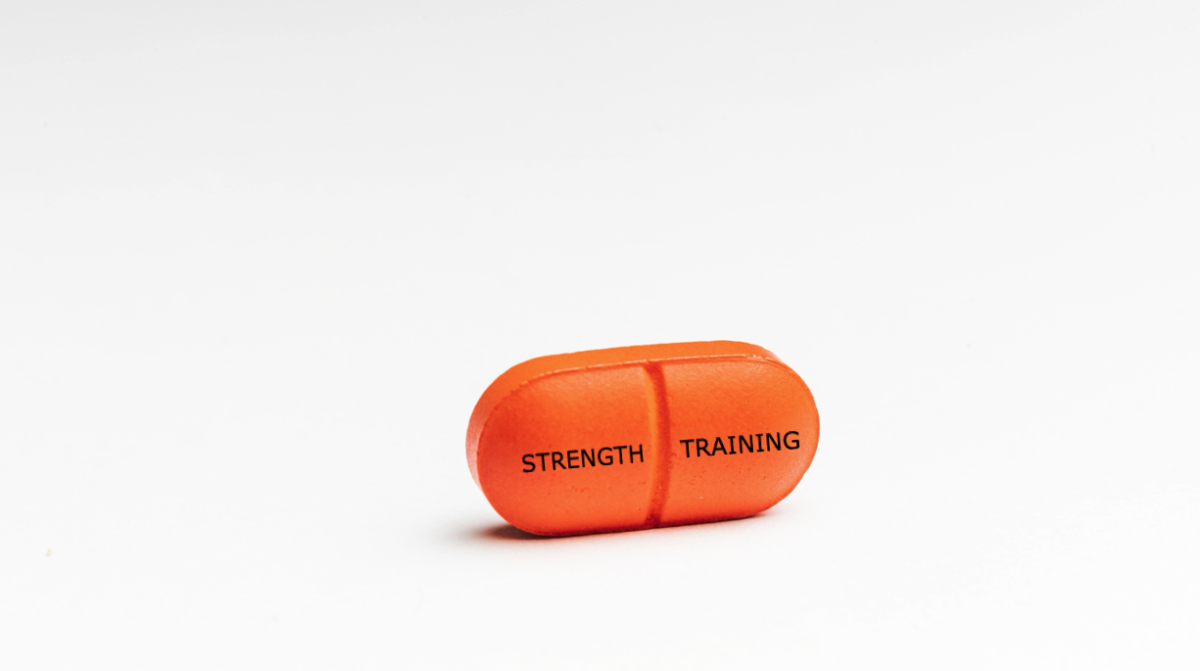If we could find fitness in a magic pill – and I’m not the first to suggest this, of course – everyone would take it. But alas, we can’t. What we need – exercise – is potentially uncomfortable, inconvenient, and for many, intimidating. And this “gymtimidation” is likely most prevalent when it comes to strength training.
Maybe that’s because, years ago, strength training was bodybuilding. It was a means to an end – and that end was to build muscle mass and sculpt the body. It was basically about aesthetics.
But here’s the truth: strength training is a magic pill. One that we all – 100% of us – need to swallow. So, the question is, how can we make it go down? Often and long-term?
First, since we know strength training isn’t as easy as popping a pill, we should know the benefits – the WHY, as in why it’s worth the effort. And next, we have to find something we’ll stick with – the WHAT. As in, what is the most enjoyable way to strength train?
Health Benefits of Strength Training
Versus the early days of bodybuilding, today we know strength training does so much more than build biceps. The benefits of strength training cover the full physical and mental spectrum! In fact, it’s one of the best things we can do for our overall health. Here’s a rundown of why strength training exercises are essential.
Stronger muscles: As we get older, our muscles naturally start to lose their strength and size. In fact, we can lose up to 8% of our muscle mass every decade! And there’s a villain called sarcopenia that can make this muscle loss even worse, especially for folks over 60. It can make daily tasks harder, lead to falls and fractures, and even make it tough to stay independent. Strength training is the ultimate weapon against sarcopenia and age-related muscle loss.
Improved bone density: Bones adapt to the loads placed upon them. Engaging in strength training workouts subjects the bones to mechanical stress, accelerating the remodeling of bone to make them denser and stronger.
Weight management: Strength training helps us manage our weight because, among many things, muscle tissue is metabolically active, meaning it requires more energy – calories – to maintain compared to fat tissue. By increasing muscle mass through strength training, we elevate our Basal Metabolic Rate. Strength training also improves insulin sensitivity, allowing the body to use glucose more effectively for energy rather than storing it as fat. This helps regulate blood sugar levels and reduces the risk of type 2 diabetes.
Improved joint health: Or, as I would say in Australian, “less niggles!” We all want to feel better in our bodies, which generally means fewer aches and pains. Strength training can significantly improve joint health. Simply, strong muscles surrounding a joint provide better support and protection and simultaneously stimulate the circulation of synovial fluid, which helps lubricate the joints, improve their function, and deliver essential nutrients to the cartilage, promoting joint health and repair.
Improved mental health: Can lifting weights strengthen our mental well-being? YES! Strength training triggers the release of endorphins, the brain’s natural pain relievers and mood enhancers, leading to feelings of euphoria and overall well-being, often known as the “runner’s high.” And more simply, the sense of achievement from lifting heavier weights or conquering challenging workouts can be empowering, fostering a more positive self-image.
Improved cardiovascular health: It might seem counterintuitive that strength training contributes to improved cardiovascular health because, well, we all think it’s “cardio” that does that. But there are some key links between strength training and cardiovascular health. By strengthening the heart and improving blood flow, strength training can reduce the workload on the heart and lower blood pressure levels – a significant influencer of heart disease. It also increases levels of HDL – or “good” – cholesterol and decreases levels of LDL – “bad” – cholesterol, improving overall cholesterol profiles and reducing the risk of heart disease.
Strength training has been shown to reduce markers of inflammation in the body, which can help protect against heart disease and other inflammatory conditions. And we have already covered weight management, reducing the risk of obesity, a major risk factor for cardiovascular disease.
Why Isn’t Everyone Doing It?
With a list like that, everyone should be lifting weights, right? But too many people rank lifting in the weight room right up there with public speaking, which is consistently a number one fear. Here are a few common reasons why people avoid weight training:
Intimidation. Experienced lifters, complex machines, and even social anxiety can keep people from the “public” space of a weight room. The idea of having to interact with others, or the idea of feeling judged by fellow gym-goers can be overwhelming. Plus, there’s the “what do I do?” factor. How much weight do I use? How many reps? And am I even doing this right?
Fear of injury. Many are fearful of getting injured. Is my form right? Am I lifting too heavy? Too light? A lack of knowledge about proper strength training techniques, programming, and progression can lead to fear of not knowing what to do or how to start.
Appearance. This is two-fold. So many weight rooms have 360-degree mirrors and, everywhere we look, we see ourselves, playing in to body image concerns. Second, some of us worry, “will lifting weights make me bulky?” a look that may not align with our desired physique.
Difficulty. Some avoid strength training simply because of perceived effort, i.e., “this is hard!” Strength training is often associated with intense work and that fear of discomfort or pushing ourselves beyond perceived limits can deter us from even giving it a try.
Cost. Need help navigating it all? A professional – like a personal trainer – could certainly help, but it comes at an additional expense.
Strength in a Safe Place
Back to the original topic: strength training that strengthens your desire to keep doing it. A “safe place” for 100% of people to lift weights. You need a weight room alternative: a group fitness room.
But I’m not talking about an aerobics class. I mean a strength training class. A well-designed strength training workout – set to music, full-body, led by a motivating instructor – that debunks all the excuses.
It can reduce intimidation. Think of it as safety in numbers. We blend in with the crowd, so to speak. And when everyone is following the instructor, and everyone is doing the same thing, the fear of “not doing the right thing” is massively reduced.
It can calm fear of injury. A well-trained instructor can be the guiding force a participant needs, customizing their coaching, telling us exactly what strength training exercises to do, when and even WHY.
It’s not about appearance. Again, a two-fold advantage: a room that isn’t wall-to-wall mirrors and, to battle the “bulky” worries, a strength training workout designed for group fitness isn’t about lifting maximal weights. The weights are a little lighter, making it safer and more effective for the environment – but without sacrificing the amazing benefits of lifting weights.
It diminishes the difficulty. One of the unsung heroes of strength training to music is that it creates disassociation from the discomfort of lifting weights, making it much more palatable. Add that to a community feel for accountability and strength training is more “stick-with-it-able.”
…all at a reasonable cost! Group fitness is generally included as part of a health club membership, or it’s inexpensive by streaming, like on MOSSA On Demand.
…
My magic pill for nearly 20 years has been Group Power, our strength training solution at MOSSA. It’s the most popular program in clubs across the globe and on our on-demand platform, MOSSA On Demand, proving that a group fitness program anchored in strength training, set to amazing music, can be enjoyable. Yes, a pill everyone can swallow. Group Power is designed to be universally appealing in terms of age, gender, and experience. It is periodized from workout to workout to create ongoing challenge for ongoing change.
Learn more: https://mossa.net/workouts/group-power/



 More than Muscles: Benefits of Strength Training
More than Muscles: Benefits of Strength Training New Member Onboarding: Over-Welcoming or Overwhelming?
New Member Onboarding: Over-Welcoming or Overwhelming? Team vs. Technology and the Future of Fitness
Team vs. Technology and the Future of Fitness Setting Goals for Group Fitness
Setting Goals for Group Fitness Does Exercise Have to be Boring and Bitter?
Does Exercise Have to be Boring and Bitter?